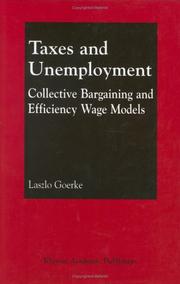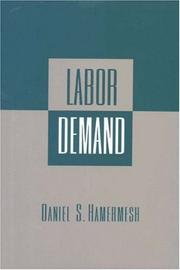| Listing 1 - 7 of 7 |
Sort by
|
Book
Year: 2017 Publisher: Liège : CIRIEC,
Abstract | Keywords | Export | Availability | Bookmark
 Loading...
Loading...Choose an application
- Reference Manager
- EndNote
- RefWorks (Direct export to RefWorks)
Employee ownership --- Efficiency wage theory --- Labor contract
Book
ISBN: 9781299715424 Year: 2012 Publisher: London ; New York Routledge
Abstract | Keywords | Export | Availability | Bookmark
 Loading...
Loading...Choose an application
- Reference Manager
- EndNote
- RefWorks (Direct export to RefWorks)
Wages and labor productivity --- Efficiency wage theory --- Labor market --- Economic development
Book
ISBN: 1138213306 0203114973 113629340X Year: 2012 Publisher: London ; New York : Routledge,
Abstract | Keywords | Export | Availability | Bookmark
 Loading...
Loading...Choose an application
- Reference Manager
- EndNote
- RefWorks (Direct export to RefWorks)
This book provides a theoretical framework to better understand how firms, economies and labor markets have evolved. This is done in a reader-friendly fashion, without complex mathematical arguments and proofs. Economic Growth and the High Wage Economy shows how high wage economies help make firms and economies more productive and why high wage economies can be competitive even in an increasingly globalized environment. It also demonstrates why concerns that labor supply will dry up as wages increase and social benefits rise are largely based on impoverished economic reasoning.
Wages and labor productivity. --- Efficiency wage theory. --- Labor market. --- Economic development.

ISBN: 0792374401 1461352398 1461507871 Year: 2002 Publisher: Boston ; London : Kluwer Academic Publishers,
Abstract | Keywords | Export | Availability | Bookmark
 Loading...
Loading...Choose an application
- Reference Manager
- EndNote
- RefWorks (Direct export to RefWorks)
This chapter has set out in detail the models which are employed below in order to analyse the labour market effects of changes in tax rates and in alterations in the tax structure. The fundamental mechanisms underlying the different approaches have been pointed out. Moreover, vital assumptions have been emphasised. By delineating the models which are used for the subsequent analyses, implicitly statements have also been made about topics or aspects which this study does not cover. For example, all workers and firms are identical ex ante. However, ex-post differences are allowed for, inter alia, if unemploy ment occurs or if some firms have to close down. These restrictions indicate areas of future research insofar as that the findings for homogeneous workers or firms yield an unambiguous proposal for changes in tax rates or the tax structure in order to promote employment. This is because it would be desir able for tax policy to know whether the predicted effects also hold in a world with ex-ante heterogeneity. Furthermore, the product market has not played a role. Therefore, repercussions from labour markets outcomes on product demand - and vice versa - are absent. 55 Moreover, neither the process of capital accumulation, be it physical or human capital, nor substitution pos sibilities between labour and capital in the firms' production function are taken into account. Finally, international competition is not modelled.
Collective bargaining --- Labor supply --- Unemployment --- Wages --- Mathematical models. --- Effect of taxation on --- Taxation --- Efficiency wage theory --- Public finance. --- Labor economics. --- Microeconomics. --- Public Economics. --- Labor Economics. --- Price theory --- Economics --- Cameralistics --- Public finance --- Public finances --- Currency question
Book

Year: 2010 Publisher: Washington, D.C., The World Bank,
Abstract | Keywords | Export | Availability | Bookmark
 Loading...
Loading...Choose an application
- Reference Manager
- EndNote
- RefWorks (Direct export to RefWorks)
It has been well established that the wages of individual workers react little, especially downwards, to shocks that hit their employer. This paper presents new evidence from a unique survey of firms across Europe on the prevalence of downward wage rigidity in both real and nominal terms. The authors analyse which firm-level and institutional factors are associated with wage rigidity. The results indicate that it is related to workforce composition at the establishment level in a manner that is consistent with related theoretical models (e.g. efficiency wage theory, insider-outsider theory). The analysis also finds that wage rigidity depends on the labour market institutional environment. Collective bargaining coverage is positively related with downward real wage rigidity, measured on the basis of wage indexation. Downward nominal wage rigidity is positively associated with the extent of permanent contracts and this effect is stronger in countries with stricter employment protection regulations.
Bargaining power --- Central banks --- Collective bargaining --- Efficiency wage theory --- Employment --- Environment --- Environmental Economics & Policies --- Income --- Labor Markets --- Labor markets --- Labor Policies --- Labour --- Labour markets --- Macroeconomics and Economic Growth --- Markets and Market Access --- Nominal wages --- Real income --- Real wages --- Rents --- Rigid wages --- Skilled workers --- Social Protections and Labor --- Unemployment --- Wage flexibility --- Wage increases --- Wage rigidities --- Wage rigidity --- Wages
Book

Year: 2010 Publisher: Washington, D.C., The World Bank,
Abstract | Keywords | Export | Availability | Bookmark
 Loading...
Loading...Choose an application
- Reference Manager
- EndNote
- RefWorks (Direct export to RefWorks)
It has been well established that the wages of individual workers react little, especially downwards, to shocks that hit their employer. This paper presents new evidence from a unique survey of firms across Europe on the prevalence of downward wage rigidity in both real and nominal terms. The authors analyse which firm-level and institutional factors are associated with wage rigidity. The results indicate that it is related to workforce composition at the establishment level in a manner that is consistent with related theoretical models (e.g. efficiency wage theory, insider-outsider theory). The analysis also finds that wage rigidity depends on the labour market institutional environment. Collective bargaining coverage is positively related with downward real wage rigidity, measured on the basis of wage indexation. Downward nominal wage rigidity is positively associated with the extent of permanent contracts and this effect is stronger in countries with stricter employment protection regulations.
Bargaining power --- Central banks --- Collective bargaining --- Efficiency wage theory --- Employment --- Environment --- Environmental Economics & Policies --- Income --- Labor Markets --- Labor markets --- Labor Policies --- Labour --- Labour markets --- Macroeconomics and Economic Growth --- Markets and Market Access --- Nominal wages --- Real income --- Real wages --- Rents --- Rigid wages --- Skilled workers --- Social Protections and Labor --- Unemployment --- Wage flexibility --- Wage increases --- Wage rigidities --- Wage rigidity --- Wages

ISBN: 0691025878 0691042543 0691222991 9780691042541 Year: 1996 Publisher: Princeton, New Jersey : University Press,
Abstract | Keywords | Export | Availability | Bookmark
 Loading...
Loading...Choose an application
- Reference Manager
- EndNote
- RefWorks (Direct export to RefWorks)
In this book Daniel Hamermesh provides the first comprehensive picture of the disparate field of labor demand. The author reviews both the static and dynamic theories of labor demand, and provides evaluative summaries of the available empirical research in these two subject areas. Moreover, he uses both theory and evidence to establish a generalized framework for analyzing the impact of policies such as minimum wages, payroll taxes, job- security measures, unemployment insurance, and others. Covering every aspect of labor demand, this book uses material from a wide range of countries.
331.52 --- Labor demand --- Labor market --- Employees --- Market, Labor --- Supply and demand for labor --- Markets --- Demand, Labor --- Demand for labor --- 331.52 Arbeidsmarktstructuur. Vraag en aanbod op de arbeidsmarkt. Spreiding van arbeidsplaatsen. Spreiden van arbeidskrachten. Tewerkstellingsgraad --- Arbeidsmarktstructuur. Vraag en aanbod op de arbeidsmarkt. Spreiding van arbeidsplaatsen. Spreiden van arbeidskrachten. Tewerkstellingsgraad --- Supply and demand --- Labor demand. --- 331.526 --- 331.123 --- Levels of employment. Employment situation, conditions --- #A9402E --- 331.526 Levels of employment. Employment situation, conditions --- 332.630 --- 332.691 --- AA / International- internationaal --- Strijd tegen de werkloosheid: algemeen. Theorie en beleid van de werkgelegenheid. Volledige werkgelegenheid --- Evolutie van de arbeidsmarkt --- Labour market --- Labor market. --- Marché du travail --- Mercado de trabajo. --- Cobb–Douglas production function. --- Comparative advantage. --- Compensating differential. --- Contract curve. --- Cost curve. --- Demand For Labor. --- Demand response. --- Derived demand. --- Developed country. --- Developing country. --- Earnings. --- Economic cost. --- Economic efficiency. --- Economic forces. --- Economic interventionism. --- Economics. --- Efficiency wage. --- Efficiency. --- Elasticity of intertemporal substitution. --- Elasticity of substitution. --- Employment. --- Endogenous growth theory. --- Estimation. --- Excess supply. --- Externality. --- Factor cost. --- Factor price. --- Implicit cost. --- Income elasticity of demand. --- Indifference curve. --- Induced innovation. --- Inelastic. --- Inflation. --- Instrumental variable. --- Investment goods. --- Isoquant. --- Job security. --- John Haltiwanger. --- Labour supply. --- Law of demand. --- Layoff. --- Living wage. --- Long run and short run. --- Mandatory retirement. --- Manufacturing in the United States. --- Marginal cost. --- Marginal product. --- Marginal rate of substitution. --- Marginal rate of technical substitution. --- Maximum wage. --- Minimum wage. --- Monopsony. --- Neoclassical economics. --- Net Change. --- Net investment. --- New Keynesian economics. --- Oligopoly. --- Outsourcing. --- Partial equilibrium. --- Payroll tax. --- Phillips curve. --- Present value. --- Price Change. --- Price elasticity of demand. --- Price elasticity of supply. --- Production function. --- Productive efficiency. --- Productivity. --- Profit (economics). --- Profit maximization. --- Real business-cycle theory. --- Real versus nominal value (economics). --- Real wages. --- Recession. --- Reservation wage. --- Response Lag. --- Risk aversion. --- Scarcity. --- Shephard's lemma. --- Shortage. --- Stephen Nickell. --- Subsidy. --- Substitution effect. --- Supply (economics). --- Supply and demand. --- Supply shock. --- Tax incidence. --- Tax. --- Theory of the firm. --- Time preference. --- Total cost. --- Total factor productivity. --- Trade barrier. --- Unemployment in the United States. --- Unemployment. --- Utility. --- Utilization. --- Variable cost. --- Wage.
| Listing 1 - 7 of 7 |
Sort by
|

 Search
Search Feedback
Feedback About UniCat
About UniCat  Help
Help News
News